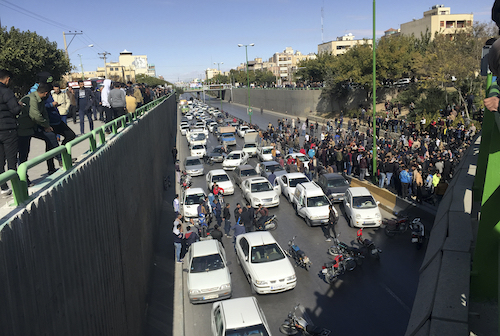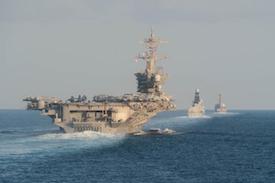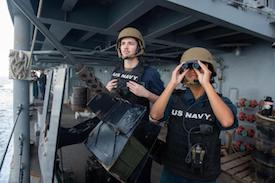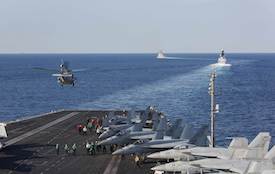U.S. pressure, internal problems a dangerous mix in Iran
By Brian E. Muhammad -Contributing Writer- | Last updated: Dec 10, 2019 - 11:43:23 AMWhat's your opinion on this article?
The United States Pentagon is considering sending several thousand additional troops to the Middle East in what is understood as part of continued antagonism with the Islamic Republic of Iran. Testifying before Congress, John Rood, the undersecretary of defense for policy, said the United States was “observing Iran’s behavior with concern.”

“We’re continuing to look at that threat picture and have the ability to dynamically adjust our force posture,” Mr. Rood told the Senate Armed Services Committee Dec. 5.
Although a definitive decision has not been taken, the consideration follows several decisions to beef up the U.S. military presence in the region, said Associated Press.
“The most realistic options include potentially sending 4,000 to 7,000 additional U.S. troops to the region the officials said,” according to CNN. Iranian missiles “could pose a threat to U.S. forces in Iraq and potentially be moved to threaten Saudi Arabia as well” and a “need for additional air defenses could be met by combinations of ground-, air- and sea-based U.S. forces,” CNN reported Dec. 5.
The discussion comes amid mid-November protests inside Iran triggered by price hikes of subsidized gasoline that spiraled into violence. The Iranian government said the destruction was deliberate chaos perpetrated by anti-government forces backed by foreign foes like America, Israel and Saudi Arabia.
Analysts said the intensity of violence is a combination of factors from within and outside of Iran.
“This is about agency of people within Iran who are rising up with a host of demands that are not so dissimilar to what’s going on in Lebanon, Chile … other places in the world,” said Phyllis Bennis, a fellow at the Institute for Policy Studies in Washington, D.C.
But, U.S. imperialism is a major factor that’s agitating domestic upset within Iran and at worst the possibility of war.
“U.S. sanctions are a big part of what has made peoples’ lives miserable … that’s part of what people are responding to,” Ms. Bennis added.

She doesn’t think America is fomenting the turmoil in the sense of paying people or orchestrating people to go out in the streets. “This is not a color revolution,” she argued, adding “this is homegrown indigenous Iranian responses to a set of conditions that include U.S. sanctions that are crippling the economy.”
Young Iranians, under 30 years old, make up over 60 percent of Iran’s 80 million people but can’t find jobs, said analysts.
According to media reports, the Iranian intelligence ministry said security agents arrested at least eight people linked to the CIA during deadly unrest.
Supreme Leader Ayatollah Ali Khamenei described two weeks of violence as the work of a “very dangerous conspiracy.”
“Iranians have the right to resolve their own problems without outside interference, just as the U.S. has claimed its right to conduct elections free of Russian influence. Self-determination is a right of every nation,” said the Honorable Minister Louis Farrakhan of the Nation of Islam in a November 2018 statement about Iran. In the past, he has urged Iranian leaders to listen to legitimate voices of dissent, especially the voices of young people. He has advised engaging young people to bring about an “evolution of the revolution” that started in 1979 with the ouster of the U.S.-backed Shah of Iran and taking American embassy personnel hostage. Min. Farrakhan has previously called on Iran’s leaders to deal with “positive dissatisfaction,” linked to legitimate Iranian desires and beware of manipulation of dissatisfaction by the U.S. and other countries.
The Minister has warned America against meddling in Iranian affairs and pushing military action that could engulf the region and kick-off the Bible’s global war of Armageddon. There are also many who believe Iranians will close ranks, if problems with the U.S. erupt into a shooting war.

Min. Farrakhan has also called for competing Muslim Sunni and Shiite nations to find a path to dialogue and reconciliation to keep outside forces from exploiting their differences.
There is much misinformation floating in the media on what is happening on the ground, said Mana Mostatabi, communications director for the National Iranian American Council, in a telephone interview with The Final Call.
“This lack of clarity … information has really given an opportunity to the U.S. government—which has taken a super hard line on Iran—to really try and impose what they want and what their will is on a cause that really doesn’t belong to them,” said Ms. Mostatabi.
The Washington, D.C.-based group of Iranian Americans wants to see change in Iran, but disagrees with U.S. meddling.
Ms. Mostatabi said if the U.S. government’s stated intent really is to support the political aspirations of the Iranian people, its policy must reflect that. “If we support them, we can’t sanction them to death.
“As an Iranian American, my government is here, but my family in Iran, that’s their government” for them to decide, she said.
Ms. Mostatabi said Iranians tell her they don’t want the Americans getting involved to make decisions about their government.
The Trump administration accused Iranian security forces of killing more than 1,000 people in protest crackdowns. According to Time magazine online, the numbers were unsubstantiated and higher than figures from human rights groups.

Brian Hook, the U.S. special representative for Iran, told reporters the figure were based on intelligence reports and video footage sent by people in Iran.
However, Alireza Miryousefi, a spokesman for Iran’s mission to the United Nations disputed any casualty figures from abroad as “purely speculative and highly inaccurate.”
“Mr. Hook has already said in public that he is very pleased with the suffering of ordinary Iranians, and that the U.S. has had arrangements in the past two years to maximize what occurred with the recent violence and damages in Iran,” Mr. Miryousefi told The Associated Press.
Iran-U.S. relations soured for nearly 40 years since the Islamic Revolution toppled the American backed puppet regime. There was a thaw after decades of sanctions and political isolation with the 2015 Iran Nuclear Deal brokered by President Barrack Obama and signed by Iran and major world powers. The agreement promised to lift the sanctions.
Earlier this year, President Trump reversed the deal and applied stiffer sanctions on Iranian oil and banking sectors and pressured other nations to comply. Iran now faces an existential threat from the U.S., say observers. And, Iran pulled back on its nuclear commitments in response to the threat.
Iran has maintained its measures will be reversed if Europe finds practical ways to shield mutual trade agreements from the U.S. sanctions.
The unilateral move by America has caused a rift with some world powers. Press TV, Iran’s English language channel and website, reported that China has called on America to end its maximum pressure campaign, threats of deploying more troops to the Middle East and find a diplomatic solution.
“The United States is not only unilaterally withdrawing from the Joint Comprehensive Plan of Action (the nuclear deal) and exerting maximum pressure on Iran but is also imposing sanctions or threatening to impose sanctions on other parties within the agreement,” said Chinese Foreign Ministry spokeswoman Hua Chunying on Dec. 6.
The Supreme Leader of the Islamic Republic urged state bodies to honor “Islamic mercy” in regard to those who committed violent acts and caused insecurity in bloody protests.
Ayatollah Khamenei expressed the sentiment Dec. 4 while addressing counter-riot forces in the country responding to mayhem.
“The organizers had spent a hefty amount of money to materialize their objectives,” the ayatollah said. The enemies imagined the dissatisfaction that spurned the protests would be the best opportunity for them to insert provocateurs among protesters, he said. However, he applauded anti-riot demonstrators who he said foiled their plot.
“Despite the frustrations that many Iranians have with their political leaders, modern Iranian history teaches that one of the core themes in the country’s political culture is the struggle for independence from foreign powers,” said Narges Bajoghli, assistant professor of Middle East studies at Johns Hopkins University in a June 2019 N.Y. Times OpEd.
“As long as the Trump administration believes it can use sanctions and hostile rhetoric to drive a wedge between the Iranian public and its leaders, the Revolutionary Guards will use that same pressure to enforce solidarity behind it and the regime—and defeat any attempt by the West to bring change to Iran,” Ms. Bajoghli said.
President Trump, at different times, has threatened Iran and tried to increase tension between the Shiite nation and its Sunni rivals. In 2017, Saudi Arabia, a major Iranian opponent, reached agreements with the United States to spend $110 billion on U.S. arms right away and $350 billion over 10 years. In May, President Trump, saying there was national emergency because of problems with Iran, sold over $8 billion worth of weapons to Saudi Arabia, the United Arab Emirates and Jordan. Congress had been holding up sales in response to the Saudi-led war in Yemen and the killing of dissident journalist Jamal Khashoggi inside the Saudi consulate in Turkey. Iranians have responded with determination to resist U.S. aggression.
INSIDE STORIES AND REVIEWS
-
-
About Harriett ... and the Negro Hollywood Road Show
By Rabiah Muhammad, Guest Columnist » Full Story -
Skepticism greets Jay-Z, NFL talk of inspiring change
By Bryan 18X Crawford and Richard B. Muhammad The Final Call Newspaper @TheFinalCall » Full Story -
The painful problem of Black girls and suicide
By Charlene Muhammad -National Correspondent- » Full Story -
Exploitation of Innocence - Report: Perceptions, policies hurting Black girls
By Charlene Muhammad -National Correspondent- » Full Story -
Big Ballin: Big ideas fuel a father’s Big Baller Brand and brash business sense
By Bryan Crawford -Contributing Writer- » Full Story






 Click Here Stay Connected!
Click Here Stay Connected!








